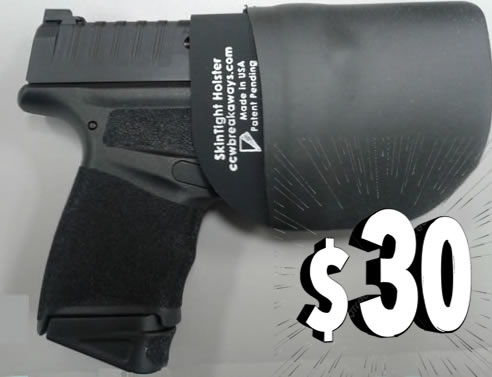
10mm vs 45ACP
If you’re looking for a powerful cartridge for your semi-auto handguns. Then it boils down to a couple of choices.
The 10mm and the .45 ACP.
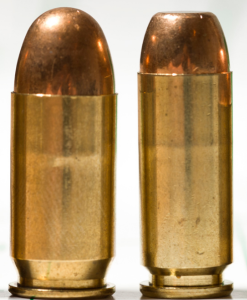
Both of these are widely popular so many will have a difficult decision to choose.
Some folks that have the money will get both. However, for this scenario we need to choose one.
Even if you do own both a 10mm Auto and a .45 ACP handgun, how do you know which one is best for certain task?
Both of their capabilities overlap each other but their characteristics and traits differ.
Each has distinct strengths and weaknesses.
Anyways, we’ll keep this un-biased and help you decide which one is best for you.
Brief History
.45 ACP: John Browning’s Masterpiece
John Browning .45 ACP is the iconic cartridge for over 100 years.
His thinking was on designing a cartridge to shoot a big full metal jacket, slow bullet that has knock down power, alias “man-stopper”.
It was a highly popular among gun enthusiasts.
Typically a .45 ACP load is a 230-grain bullet that fires at 830 fps for 355 foot-pounds of muzzle energy.
This was the gold standard for short range with knock down power in a handgun, this ruled for many decades.
As mentioned earlier using FMJ ammunition is highly effective in a .45 ACP.
The military adopted the legendary 1911 pistol that drove the .45 ACP in all of our military wars from World War I to Vietnam and other small conflicts throughout the globe.
This cartridge even found its way into the law enforcement world, gun hobbyist and hunters in the U.S.
Many manufactures make this popular 1911 pistol, these includes:
Colt, Dan Wesson, Kimber, Remington, Rock River, Sig Sauer and Springfield. Obviously, not the complete list.
Popular Glocks also makes it in .45 ACP as well for those that don’t prefer the 1911 model. Glock offers:
the Glock 21 (full-size), 30 (compact), 36 (sub-compact) and 41 (competition). The same goes for the H&K45, the Ruger American, SR45 and the Springfield XD.
One of the big thing about the .45 ACP is its big recoil, but most hard-core gunners don’t find this a problem.
Competitive shooters love the .45 ACP because its very accurate. The round itself is very affordable and available everywhere, online or in-store.
10mm Auto: Jeff Cooper’s Conception
During the 1970s and 80s shooter only had 2 choices for the semi-automatic handgun cartridges, it was the 9mm Luger and the .45 ACP.
The .45 ACP went with the “slower heavier bullet” route while the 9mm went the opposite direction with a lighter high velocity bullets.
Legendary gun trainer Jeff Cooper wasn’t satisfied with the two cartridges. So, he teams up with the Swedish ammunition company Norma A.B. to build what he considered the ideal combat handgun cartridge.
The result was the 10mm auto: its a medium-bore cartridge that really has a “kick ass” punch.
First introduced in 1983, the original load was a .40-caliber, 200-grain bullet at 1,200 fps for a 759 foot-pounds of muzzle energy.
Dornaus & Dixon Enterprises came out with the first production of the Bren Ten which was very popular.
However, the company suffered many production issues which forced the company to go into bankrupt.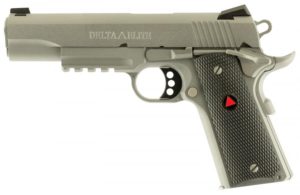
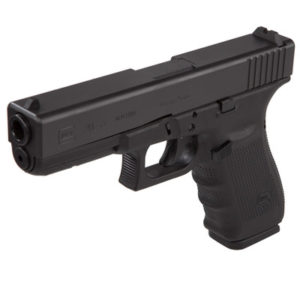
With the demise of the Bren Ten and there wasn’t any other 10mm pistols in mass production at the time.
Other big manufactures like Colt and Glock decides to fill this gap.
Colt produced the “Delta Elite”, a modified 1911 that propels the 10mm.
Glock followed suit few years later with its Glock 20.
For those that wanted more variety of 10mm pistols to choose from, there just wasn’t that many available compared to the .45 ACPs.
Glock also had the G40 with the long-slide released in 2015 which was popular among hunters and shooters.
Few others have started showing up on the market radar such as:
Kimber
Sig P220
Dan Wesson Razorback
Wilson Combat Hunter (Ted Nugent)
The FBI even looked at adopting it, but had its 10mm design in lite mode back in the 80s. The cause for the reduced-power 10mm was due to their agents not being able to handle its stout recoil.
Smith&Wesson eventually came out with a .40 S&W, which was a shortened cartridge that had the same capabilities as the 10mm.
Hunters like its the 10mm because of its hard-hitting, flat-shooting characteristics, which is great for deer hunting.
It also passes as a bear-defense cartridge.
-One of the big complaint for 10mm’s is the power, this creates huge recoil.
But is it that bad of a recoil?
Many experienced shooters have attest that 10mm recoils only a little more with than the .45 ACP. So, well-trained shooters using good quality handguns can handle it without much trouble. So maybe, not for the newbie.
-10mm ammunition isn’t as common as the .45 ACP’s.
Here are some of the major ammo manufactures that make 10mm.
- Barnes
- Buffalo Bore
- Double Tap
- Federal
- Hornady
- Remington
- Sig Sauer
- Underwood
- Winchester
-Another downside to 10mm cartridge is the cost, it does cost more than the .45 ACPs.
Which Cartridge is Best for You?
So which one should you buy?
Just like with everything, it’s really a matter of what you intend to use your handgun for.
On the 10mm side of the fence they like to point out that it has more energy at 100 yards vs the .45 ACP does at the muzzle.
But, the .45 ACP counters that it is bigger at 100 yards than the 10mm at the muzzle.
The 10mm Auto devotees point out that the 10mm has more energy remaining at 100 yards than the .45 ACP does at the muzzle. Fans of the .45 ACP counter that the .45 is bigger at 100 yards than the 10mm is at the muzzle.
As you can see the table below, both of these statements are true.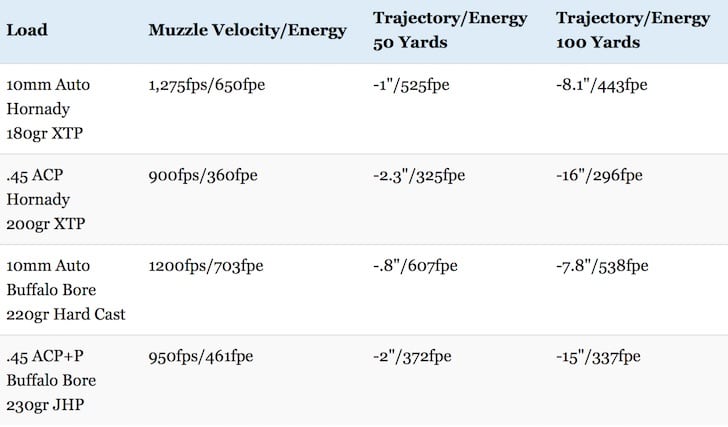
However, those statements also points to the strengths, weaknesses and ideal uses of respective cartridge.
The .45 ACP when combined with high-quality ammor for short range is an awesome choice for self-defense.
The recoil is much easier to handle in compact and/or sub-compact handgun than 10mm.
For the concealed carrier its ideal because of the smaller frame.
Taking follow-up shots rapidly is way lots easier.
This cartridge won’t break the bank if you’re using it for plinking.
For the 10mm Auto folks that use this baby in their hunt, this is the way to go.
It shoots a lighter bullet at a much faster muzzle velocity than the .45. In physics this means it has more kinetic energy and the cartridge has a flatter trajectory than the .45 ACP. Which means reaching out and touching an animal from a distance is easy.
When the 10mm hit its target it hits it harder than the .45 and makes larger wound holes. That also translate to putting down your game than a .45 ACP.
Even if the .45 user was packing Buffalo Bore with P+, 10mm Hornady XTP loads is in a league of its own.
For these same reasons, it’s a better cartridge to use than the .45 ACP for personal defense against large four-legged predators.
That’s not to say that the 10mm won’t work against a human assailant, but just keep the costs of the cartridge in mind before you decide to use it in that role.
If you’re looking to use a 10mm in a smaller framed handguns for CCW. Its going to be harder to handle when shooting.
We may be beating this over a dead horse here but 10mm has more recoil than the .45.
Over-penetration is another concern with the 10mm.
These issues are less of a problem in a home-defense situation, though, particularly when using high-quality defense rounds for the .45s.
Parting Shots
Regardless of which cartridge you pick, test out a couple of different handguns and choose the one that fits your needs.
Use high-quality ammunition and spend plenty of time out at the range so that you get comfortable with the loads. As long as you practice neither the 10mm Auto nor the .45 ACP is likely to let you down.


